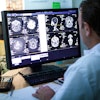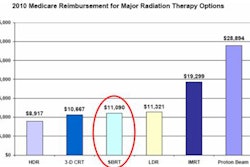The lessons learned during the H1N1 pandemic by a Toronto radiology group are instructive for any radiology department seeking to be maximally effective during both normal conditions and emergencies, according to presentations at the Canadian Association of Radiologists (CAR) annual meeting held in April in Montreal.
On May 6, 2009, the first staff member at the Joint Department of Medical Imaging (JDMI) was confirmed to have contracted H1N1. The department's leadership soon discovered they had to throw out their plans for dealing with the pandemic -- which were based on their being at ground zero during the 2002-2003 severe acute respiratory syndrome (SARS) crisis -- and start again from scratch. But their effort should help them deal with virtually any future challenge.
"One of our major thrusts was creating a culture of one cohesive team across all five of our sites; across professions, divisions/specialties, and functions," recalled Catherine Wang, senior director of JDMI. "That included more closely connecting the radiologists with the medical imaging department, and the department with the other clinical programs in the hospital. Because in the context of pandemic preparedness, all of the various points of intersection that work or don't work get magnified -- if you're not in sync with the rest of the hospital, you start to feel it."
The Toronto situation
JDMI serves five hospitals, including three hospitals in the University Health Network (UHN) --- Toronto General Hospital, Toronto Western Hospital, and Princess Margaret Hospital -- as well as Mount Sinai Hospital and Women's College Hospital. The other tertiary- and quaternary-care hospitals in the greater Toronto area, which has a population of 5.5 million, are St. Michael's, Sunnybrook, and Sick Children's hospitals.
Toronto had already gone through the SARS crisis, but it quickly became clear that H1N1 posed a different type of threat.
"I got the call saying one of our staff members had contracted H1N1, and the other staff wanted to know what they should do," said Wang. "At the time, we had decided to minimize movement between hospital sites, just as we had done for SARS. ... We changed our position later on when we realized that that wasn't appropriate for H1N1, because H1N1 is a community-based disease and staff and patients could contract H1N1 just as easily in the community as they could in the hospital."
Wang and the others involved in planning for the pandemic realized they had underestimated the scope and extent of planning necessary to deal with H1N1. Thus, they rapidly gathered information about the potential effects of H1N1 and how to mitigate them.
They created a central command group overseeing logistics, planning, and operations groups. The three main functions of the logistics group were to set up vaccination kiosks throughout the UHN; to ensure there were always adequate supplies, including vaccines, masks, and other essential materials; and to coordinate communication between management, staff, and physicians throughout the crisis.
The planning group members formulated the priorities for dealing with each phase of the pandemic, including making plans for staff redeployment to areas of need. The latter was based on a detailed skills inventory conducted in each department. Operations focused on maintaining optimal patient care, including creating secondary assessment centers to divert patients from the emergency departments of Toronto Western Hospital and Toronto General Hospital. Staff members received information about H1N1 planning from the command group, and department-specific details were disseminated via the JDMI leadership team members.
There also was an H1N1 committee in each department, and Kathy Hilario led JDMI's committee. She is also site manager for Toronto Western Hospital and a CT/general radiology modality manager for JDMI. Thus, the emergency response was simply plugged into the existing management structure.
Impact on radiology
All physicians, including radiologists, were expected to be mask-fit tested, and everyone was encouraged to obtain an H1N1 vaccination. However, UHN physicians are not employees, and therefore full compliance with all hospital policies and procedures is not easy to achieve, noted Marnie Weber, UHN's senior director of strategic development.
Fortunately, thanks to a fit-testing blitz for physicians, residents, and fellows -- including teams that conducted mask-fit testing right in physicians' offices -- 47.8% of physicians, including 57% of radiologists, were fit-tested over a three-month period. In addition, 75% of employees were fit-tested, including 91% of nonmedical staff in the JDMI. The rate of vaccination could not be tracked because people received vaccines at many clinics in hospitals and elsewhere across the greater Toronto area.
Within JDMI, Hilario oversaw the creation of a detailed skills inventory of all clinical and nonclinical staff. Other departments subsequently followed suit. The goal was to be prepared to move staff around appropriately within JDMI and the rest of the hospitals' departments during the pandemic if a significant number of people had to stay at home due to themselves or their loved ones contracting H1N1. The radiologists were not included in this inventory, because "skills are pretty much based on subspecialty via division structure, and they were protected from overall hospital redeployment plans," explained Wang.
Hilario also worked with the rest of the JDMI leadership and the members of the crisis logistics group to communicate constantly with staff.
"At the leadership team meetings, if questions came to the table from staff, we would provide answers that would be disseminated to all staff via our supervisory and management leaders' teams," Hilario said. "So there was consistent messaging in response to staff concerns, including to pregnant workers and other staff members who were concerned about their personal safety."
In addition, 12 town hall meetings were held to keep everyone at the UHN informed during each phase of the pandemic. This helped to calm people's fears about infection, especially during the near-hysteria in the summer of 2009 triggered by extensive media coverage of the H1N1-related death of a Toronto teen.
H1N1 ran its course
Fortunately, the pandemic did not reach the proportions anticipated by officials, either in Toronto or around the world. In total, only 89 patients with an H1N1 infection were admitted to the UHN hospitals in that period; 20 were placed in the intensive care unit. And only 27 JDMI staff and employees took time off for illness: They took a total of 553 sick hours over the course of the pandemic, from April to December 2009.
Some staff redeployment was necessary but not at the levels planned. Also, no JDMI-related service reductions were necessary. Moreover, the overall level of radiology activity closely matched what was anticipated for the pandemic. The only exception was the 10% higher number of CT scans performed in general radiology compared to budgeted volumes.
"Emergency-preparedness planning is becoming a core competency for hospital leaders," noted Wang. "It's becoming the new norm -- in the past few years, we've managed through SARS, H1N1, blackouts, fires, etc. We try to ensure that we have structures and processes in place that are adaptable to the situation at hand."
By Rosemary Frei
AuntMinnie.com contributing writer
May 11, 2010
Related Reading
X-ray features predict poor H1N1 prognosis, March 23, 2010
Case report: Imaging tracks course of H1N1 in girl, February 12, 2010
Study categorizes x-rays of kids with swine flu, December 24, 2009
Chest CT depicts H1N1 better than radiography, October 21, 2009
Copyright © 2010 AuntMinnie.com



















